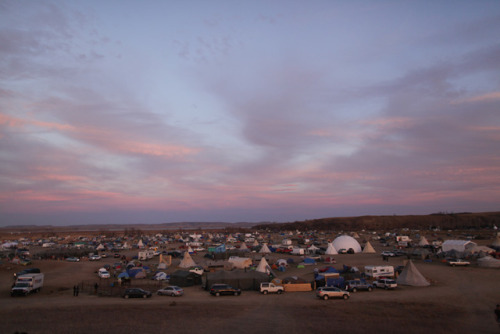archatlas:This Is What Life Inside the Standing Rock Camp Looks Like Right NowAn excerpt from a ph
archatlas:This Is What Life Inside the Standing Rock Camp Looks Like Right NowAn excerpt from a photo essay, published on The Nation, from Standing Rock, where indigenous activists pray and prepare for winter, even as police brutality mounts by Jake Ratner:Coming over the hill on Highway 1806 in late October, the sprawling Standing Rock encampment surged into view. Tipis, tents, and a geodesic dome dotted the valley below. Nestled along the Cannon Ball and Missouri Rivers in remote North Dakota, the Oceti Sakowin camp had recently grown to over 7,000 people.Those camped there have led a months-long effort to resist the construction of the Dakota Access Pipeline. The 1,170-mile pipeline is slated to transport crude oil from the Bakken shale fields of North Dakota, through Standing Rock Sioux treaty land, under the Missouri River, and on to Illinois. The Standing Rock “water protectors,” however, fear that the pipeline will poison the river and with it, the water supply not only for the Standing Rock Sioux but the millions of others who live downstream. And so they pray and march and refuse to move. So far, their efforts have managed to halt the pipeline’s advance at the west bank of the Missouri pending a final permit from the Army Corps of Engineers.This period of relative tranquility, however, was broken this past Sunday as police from the Morton County Sheriff’s Department confronted some 400 water protectors on Backwater Bridge just north of camp. According to a report from Dallas Goldtooth, an organizer with the Indigenous Environmental Network, the protectors were attempting peacefully to move a burned-out truck off the bridge and clear access to the public roadway when police trapped them on the bridge and opened fire with tear gas, rubber bullets, mace canisters, and concussion grenades. While this level of brutality and violence against peaceful demonstrators is clearly extreme, it was not the first time the water protectors have been met by blunt force and intimidation. Nor is it likely to be the last. Native peoples in this country have faced every tool the U.S government has to displace, dispossess, and destroy them for more than 500 years.Yet as the winter comes, the water protectors are not giving up. Their movement is part of a long history of struggle. And regardless of what brutal force it faces, it isn’t going away.ViaSee more ARCHy here. -- source link
Tumblr Blog : archatlas.net
#standing rock







